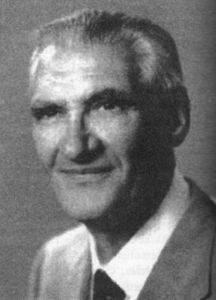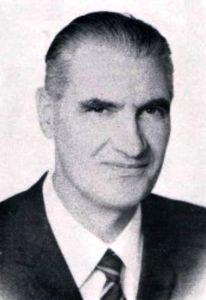Historical merit of our land
 He was born in Bussana (at that time an autonomous municipality and today a hamlet of Sanremo) on 20th August 1914 from the lawyer Alarico and Caterina Ricolfi, who belonged to two of the oldest families in the village.
He was born in Bussana (at that time an autonomous municipality and today a hamlet of Sanremo) on 20th August 1914 from the lawyer Alarico and Caterina Ricolfi, who belonged to two of the oldest families in the village.
After completing his secondary school studies, he enrolled in the Faculty of Letters at the University of Genoa, where he graduated on 5 November 1938 with a thesis in classical archaeology on the Roman ruins of Western Liguria.
In 1936 he enrolled in the Ligurian Society of Homeland History, of which he would have been vice president from 1985 to 1995.
During the Second World War he fought on the Greek-Albanian front as an infantry officer, passing in January 1942 to the security unit of the concentration camp of Cairo Montenotte.
For his war activity he was also awarded a Cross of Merit for war.
In 1946 he started collaborating with the "Rivista Ingauna e Intemelia" of the International Institute of Ligurian Studies of Bordighera, for which "Collana storico-archaeological series of Western Liguria" was also published in 1950, a volume dedicated to the medieval relations between Genoa and Western Liguria between the 10th and 13th centuries.
As part of the formation of the various sections of the Institute, Calvini was particularly interested in that of Imperia, while deep disagreements emerged with Lamboglia on the general direction to be given to the Institute's activities.
In 1949, during the inactivity of the Ligurian Society of Homeland History, and with the consent of some professors of the Genoese university, including Giorgio Falco and Geo Pistarino, he promoted the foundation, together with Teofilo Ossian De Negri, of the "Bollettino Ligustico per la Storia e la Cultura Regionale".
The following year he obtained a specialization in Archivistics and Palaeography at the University of Genoa, where in 1952 he became assistant professor of Medieval History and four years later he became professor of Archivistics.
As Director of the Sanremo State Archives Section (a position he held from 1951 to 1963), he was among those who fought with greater energy and tenacity to obtain the return of the papers stolen by General Pinelli from Genoa in 1753; after long and laborious negotiations, he managed to bring back to our city his remarkable historical archive, which was returned in August 1956 and is now kept in the local State Archives Section.
As part of his numerous historiographical interests, he was particularly involved in the study of the ancient municipal statutes of the towns of Liguria, on which he also held a monographic course during his teaching of Archivistics at the University of Genoa.
Among his works on the Ligurian statutes are worth mentioning: The Principality of Villaregia (in collaboration with Aldo Sarchi, 1977); City of Taggia. Municipal Statutes of 1381 (1981); Municipal Statutes of Sanremo (1983); The fiefdom of Lingueglietta and its Municipal Statutes (1434) (1986); Municipal Statutes of Diano (1363) (1988) and The ancient Municipal Statutes of Badalucco (1994); afterwards those of Ortonovo in 1999 and those of Zuccarello in 2000 would have come out.
His interest in the medieval history of Liguria is also noteworthy, as evidenced not only by numerous articles and essays in magazines and periodicals, but also by the already mentioned volume on medieval relations between Genoa and western Liguria, and by the works Balestre e balestrieri medievali in Liguria (1983) and Nuovo glossario medievale ligure (1984).
On the city of Sanremo, in addition to the volume on the Statutes already mentioned and many contributions scattered in newspapers and magazines, he published an extensive History of the Sanremo Revolution of 1753 (published in two volumes in 1953 by the International Institute of Ligurian Studies in Bordighera); The Church of San Siro in Sanremo. Notes of religious history (1955); Pages of Sanremo history. The Bauma and the Convent of San Romolo. The church of S. Stefano in Sanremo. Books for and against Sanremo in the XVIII century (1978); Sanremo mille anni fa (1979) and La storia del porto di Sanremo (in collaboration with Cesare Gentili, 1986).
To the city of Taggia, in addition to the volume on the municipal statutes, he dedicated instead, in addition to various articles, the work La Cronaca del Calvi. The Convent of the Dominican P.P. and the city of Taggia from 1460 to 1623 (1982), for which he was also awarded with the nomination of "Honorary Citizen" by the municipal administration of Taggia.
He also dealt with the period of the barbarian landings and the construction of defence works in Liguria in the 16th century on which he wrote Corsarians, landings and fortifications in the far west of Liguria (in collaboration with Aldo Sarchi, 1980), the Napoleonic era in western Liguria and various topics, as attested, for example, by the volumes The ancient salt routes. From the Riviera di Ponente to the Piedmontese territory. Commerce and smuggling (in collaboration with Antonio Cugge, 1995) and La Confraria di Santo Spirito, gli Ospedali e i Monti di Pietà nell'area intemelia e sanremasca (also in collaboration with Antonio Cuggè, 1996).
There are also numerous villages in Liguria of which he described the historical and artistic events in documented and important volumes: Costarainera. Notes on civil and religious history (in collaboration with Annagrazia Cogno Zarbo and Caterina Garibbo Siri, 1988); Camporosso. Civil and religious history (1989); Apricale (in collaboration with Marco Cassini, 1991); Castellaro. History of an ancient feudal village (1992); The Principality of Seborga. A millennium of history (1992); Borgomaro. From the origins to the restoration (in collaboration with his wife Carla Soleri, 1993); History of Montalto Ligure and "Cronica Montisalti et Badaluci" (published in limited edition in 1996 on the occasion of the fiftieth anniversary of his marriage to Mrs. Carla and then republished in 1998); Historical notes on Coldirodi (1753-1815) (1997). He then devoted particular attention to his native country, on which he wrote, in addition to numerous articles, the three extensive monographs: Storia di Bussana (1978), I Bussanesi. Families, traditions, dialect (1981) and Bussana. From the old to the new town (1987).
He then devoted particular attention to his native country, on which he wrote, in addition to numerous articles, the three extensive monographs: Storia di Bussana (1978), I Bussanesi. Families, traditions, dialect (1981) and Bussana. From the old to the new town (1987).
On the famous earthquake that devastated Bussana in the 19th century, he also printed the book Il terremoto del 23 febbraio 1887 nel Ponente ligure (1987). Many studies by Calvini, including those dedicated to the Columbuses of Chiusanico, Maria Pellegrina Amoretti and the formation of rural municipalities in western Liguria, also anticipated with important new developments subsequent research by numerous historians who have dealt with the history of our province.
His participation in various conferences on Ligurian history, particularly the one on the ruling classes in the institutions of the Republic of Genoa, and his collaboration with numerous local magazines and periodicals are also significant: "Archivio Storico Italiano", "Archivio Storico di Corsica", "Giornale Storico e Letterario della Liguria", "Bollettino Storico Livornese", "Bollettino Storico Pistoiese", "Bollettino Storico Piacentino", "Rivista Ingauna e Intemelia", "A Compagna", "Le Compere di San Giorgio", "Studi Colombiani", "La Berio", "Bollettino Ligustico", "Archivio per le tradizioni popolari della Liguria", "La Casana", "Riviera dei Fiori", "Communitas Diani", "Atti e Memorie della Società Savonese di Storia Patria", "Il Menabò Imperiese", "L'Eco del Santuario del Sacro Cuore di Gesù in Bussana", "Civitas Sancti Romuli" and "A Gardiöra du Matüssian". He also collaborated in the compilation of numerous entries for the Great Encyclopaedic Dictionary of UTET, for the Biographical Dictionary of Italians of Treccani and for the Biographical Dictionary of Ligurians of the Consulta Ligure.
His vast production of scattered writings was finally collected in an anthology in four volumes, of which the first two were published in 1996 by the Provincial Administration of Imperia, while the other two were published in 2007 under the patronage of the Famija Sanremasca.
Because of his merits as a "teacher and passionate document researcher", as well as an appreciated lover of Matuzian history, the Municipality of Sanremo appointed him a "Meritorious Citizen" in 1970 at the proposal of the Famija Sanremasca.
On 25 April 1985 the Municipality of Sanremo also awarded him a "Certificate of Merit" in recognition of his participation in the first municipal council of the city after the war, in which Calvini was elected in the administrative consultations of 24 March 1946.
He died in Genoa on 23 March 1998.
(notes taken from the studies of Dr. Andrea Gandolfo di Sanremo)




